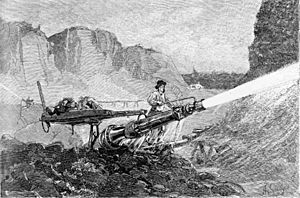Hydraulic mining facts for kids
Hydraulic mining is a form of mining that uses high-pressure jets of water to dislodge rock material or move sediment. In the placer mining of gold or tin, the resulting water-sediment slurry is directed through sluice boxes to remove the gold. It is also used in mining kaolin and coal.
Hydraulic mining developed from ancient Roman techniques that used water to excavate soft underground deposits. Its modern form, using pressurized water jets produced by a nozzle called a "monitor", came about in the 1850s during the California Gold Rush in the United States. Though successful in extracting gold-rich minerals, the widespread use of the process resulted in extensive environmental damage, such as increased flooding and erosion, and sediment blocking waterways and covering farm fields. These problems led to its legal regulation. Hydraulic mining has been used in various forms around the world.
Images for kids
-
Gold miners excavate an eroded bluff with jets of water at a placer mine in Dutch Flat, California sometime between 1857 and 1870.
-
A man leans over a wooden sluice. Rocks line the outside of the wood boards that create the sluice.
-
The Malakoff Diggins, California, showing the effects of hydraulic mining on a hillside over a century later. Much of the effects of the mining was beyond the hills themselves, on the areas downstream of the water and sediment flow they produced.
See also
 In Spanish: Minería hidráulica para niños
In Spanish: Minería hidráulica para niños







